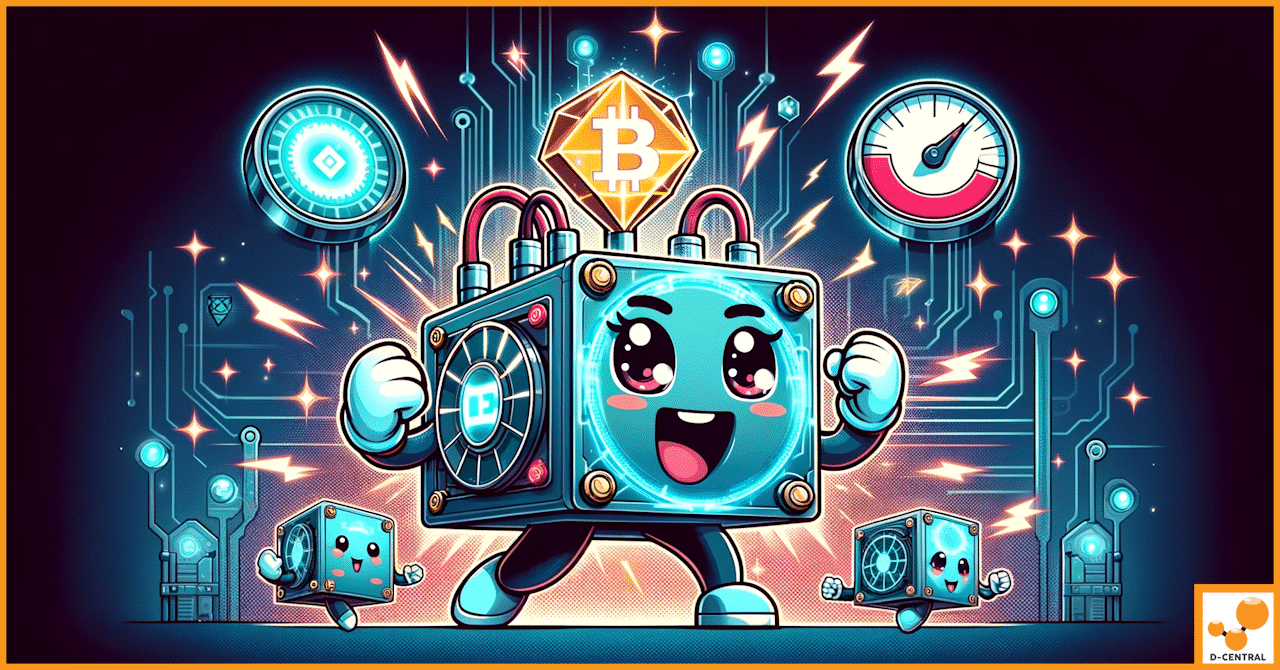
Revolutionizing Bitcoin Mining Efficiency: The Auradine Teraflux™ 15J/TH Breakthrough
In the competitive realm of Bitcoin mining, efficiency is not just a goal; it’s the linchpin of profitability and sustainability.
4479 Desserte Nord Autoroute 440, Laval, QC H7P 6E2

Bitcoin mining is more than just the process of creating new bitcoins. It’s the backbone of the entire Bitcoin network, providing the necessary security and validation for every transaction on the blockchain. This intricate process involves miners from around the world who use specialized hardware to solve complex mathematical puzzles. The first miner to solve the puzzle gets the opportunity to add a new block of transactions to the blockchain and, in return, receives a reward in the form of bitcoins. This not only incentivizes miners but also ensures the ongoing integrity and decentralization of the Bitcoin network, making it a cornerstone of the cryptocurrency ecosystem.
In the world of Bitcoin mining, power efficiency isn’t just a buzzword; it’s the key to profitability and sustainability. This is where the metric of J/TH, or Joules per Terahash, becomes crucial. It measures the energy efficiency of Bitcoin mining hardware, indicating how much energy (in Joules) is required to compute one Terahash of data. In simpler terms, it tells us how much bang we’re getting for our buck in terms of electricity usage versus mining output. As the Bitcoin network grows and the difficulty of mining increases, the J/TH of mining hardware can make or break the profitability of the mining operation. Miners with more efficient hardware (lower J/TH) will spend less on electricity costs for the same amount of mining power, giving them a competitive edge in the mining landscape.
Understanding J/TH is not just for the technically inclined; it’s essential for anyone involved in Bitcoin mining, whether you’re running a large-scale operation or a small home setup. This article aims to demystify the concept of J/TH and delve into why it matters so much in the realm of Bitcoin mining. We’ll explore how this metric impacts your mining profitability, the choices you should make when selecting mining hardware, and why, in the broader picture, J/TH is a critical factor for the sustainable growth of the Bitcoin network. In an industry where electricity consumption is a hot topic, understanding and optimizing J/TH is not just a matter of cost-efficiency; it’s also about contributing to a more environmentally responsible cryptocurrency ecosystem.
In the realm of Bitcoin mining, J/TH stands as a pivotal metric, representing the energy efficiency of Bitcoin ASIC (Application-Specific Integrated Circuit) miners. This measurement, Joules per Terahash (J/TH), is a direct indicator of how much energy, in Joules, is required to perform one Terahash of processing power.
To understand this better, let’s break down the concept of a Terahash (TH). A Terahash refers to one trillion hash computations per second. In Bitcoin mining, hashing is the process of generating fixed-size alphanumeric strings (hashes) from data of any size — in this case, from Bitcoin transactions. Each hash is unique: even a minor change in the input data results in a completely different output hash. The goal of Bitcoin mining is to find a hash that meets certain criteria set by the Bitcoin network, a process that requires immense computational power and, consequently, significant energy consumption.
The efficiency of an ASIC miner, therefore, is measured in terms of how many Joules of energy it needs to perform these trillions of hash calculations. The lower the J/TH, the more efficient the miner is. This efficiency is crucial because it directly correlates to the operational costs of mining Bitcoin.
The significance of J/TH in Bitcoin mining cannot be overstated. It’s a direct measure of how much bang you’re getting for your buck in terms of energy consumption versus mining output. A lower J/TH rating means that the miner can generate more hashes with less energy, leading to a more efficient and cost-effective mining operation.
This efficiency is particularly important given the competitive nature of Bitcoin mining. As the Bitcoin network is designed to produce a new block approximately every ten minutes, miners are in a constant race against each other to solve the cryptographic puzzle first and reap the rewards. The difficulty of this puzzle adjusts approximately every two weeks, ensuring that the rate of block creation remains steady despite the fluctuating number of miners and their collective hashing power. As the difficulty increases, miners with less efficient hardware (higher J/TH) find their operational costs rising, often to the point where mining is no longer profitable.
Moreover, the impact of J/TH extends beyond mere profitability. In a world increasingly conscious of energy consumption and its environmental impacts, the efficiency of Bitcoin mining operations is under scrutiny. Miners with lower J/TH ratings contribute to a more sustainable and environmentally friendly mining ecosystem, as they require less electricity to perform the same amount of work. This aspect of mining efficiency is becoming a crucial consideration for the industry, especially in regions where electricity generation is heavily reliant on fossil fuels.
In summary, J/TH is a critical metric in Bitcoin mining, influencing everything from individual profitability to the broader environmental impact of the cryptocurrency. Understanding and optimizing this metric is essential for anyone involved in the mining process, whether they are running a single ASIC miner at home or managing a large-scale mining farm.
The journey of Bitcoin mining hardware is a tale of relentless pursuit of efficiency. In the early days of Bitcoin, mining was possible with general-purpose hardware like CPUs (Central Processing Units) and GPUs (Graphics Processing Units). These devices, while accessible, were not optimized for mining and thus were not energy efficient. The measure of J/TH during this era was significantly high, indicating a lower efficiency.
As Bitcoin gained popularity, the mining landscape evolved with the introduction of FPGAs (Field-Programmable Gate Arrays). FPGAs offered better efficiency than CPUs and GPUs but still fell short of the ideal energy efficiency for profitable mining, especially as the network’s difficulty level rose.
The real game-changer came with the advent of ASICs. These are specialized mining devices designed exclusively for Bitcoin mining. ASICs represented a quantum leap in terms of J/TH efficiency. Over the years, ASIC technology has continually improved, leading to a significant decrease in J/TH. This progression meant that miners could achieve higher hash rates while consuming less power, drastically improving the profitability and sustainability of Bitcoin mining.
Today’s ASIC miners are marvels of engineering, optimized for maximum efficiency and power. Current models boast significantly lower J/TH ratings compared to their predecessors. For instance, early ASIC models might have had J/TH ratings well above 100 J/TH, whereas modern ASICs can operate at efficiencies as low as 30 J/TH or even lower.
Let’s consider some of the leading ASIC models in the market:
Comparing these models, it’s evident that the focus in ASIC development has been on reducing the J/TH ratio while increasing the hash rate. This trend is crucial for miners as it directly impacts their bottom line. Lower J/TH ratings mean that miners can maintain profitability even as network difficulties increase and Bitcoin rewards decrease over time.
The historical progression of mining hardware and the continual improvement in J/TH efficiency of current ASIC models are central to the economics of Bitcoin mining. As the industry evolves, this trend towards higher efficiency is likely to continue, shaping the future of Bitcoin mining.
Understanding how to calculate mining expenses using the J/TH metric is crucial for any Bitcoin miner. The formula to estimate the cost of mining is relatively straightforward but requires some key data: the miner’s hash rate, power efficiency (J/TH), electricity cost per kilowatt-hour (kWh), and the time period for calculation.
Formula: Mining Cost = (Power Efficiency (J/TH) × Hash Rate (TH/s) × Electricity Cost ($/kWh) × Time (h)) / 1,000,000
Example: Let’s consider a miner using the Bitmain Antminer S19 Pro, which has a power efficiency of 29.5 J/TH and a hash rate of 110 TH/s. If the electricity cost is $0.10 per kWh, and we want to calculate the daily mining cost:
This calculation shows that the daily cost of running this miner is approximately $7.788. The lower the J/TH, the less energy consumed for the same hash rate, leading to lower daily costs.
When choosing mining hardware, the J/TH rating is a critical factor to consider. A lower J/TH rating means higher energy efficiency, which is crucial for long-term profitability, especially considering the fluctuating nature of Bitcoin’s price and mining difficulty.
However, miners should also consider the balance between upfront costs and long-term energy efficiency. Higher efficiency ASIC miners often come with a higher price tag. The decision should be based on a cost-benefit analysis that considers the miner’s specific circumstances, including electricity costs and the intended duration of the mining operation.
For instance, a miner in a region with high electricity costs would benefit more from investing in a miner with a lower J/TH rating, despite a higher initial cost. Over time, the savings in electricity costs can significantly offset the initial investment. Conversely, in regions with low electricity costs, a miner might opt for a less expensive, slightly less efficient model, as the lower energy costs can justify the trade-off.
Key Considerations:
In summary, selecting the right mining hardware requires a careful analysis of J/TH ratings in relation to electricity costs and the miner’s specific operational strategy. Balancing upfront costs with long-term energy efficiency is key to ensuring profitable and sustainable Bitcoin mining operations.
The cost of electricity is a fundamental factor in the profitability of Bitcoin mining. It can often be the make-or-break element in determining whether a mining operation is viable. The relationship between electricity costs and mining profitability is inversely proportional; as electricity costs increase, the potential for profit decreases, assuming all other factors remain constant.
This is where the J/TH ratio of mining hardware becomes critically important. A lower J/TH ratio means that the miner is more energy-efficient, requiring fewer Joules of energy to produce one Terahash. In practical terms, this efficiency translates to lower electricity usage for the same amount of mining output. Therefore, miners with hardware that has a lower J/TH ratio can better withstand higher electricity prices, as their overall energy consumption, and thus costs, will be lower.
For example, a miner using hardware with a J/TH ratio of 90 in an area where electricity costs $0.10 per kWh will have higher operational costs compared to a miner using hardware with a J/TH ratio of 30 in the same area. The latter can achieve the same mining output with significantly less energy, thereby reducing the impact of electricity costs on overall profitability.
The importance of the J/TH ratio becomes even more pronounced when considering the global variations in electricity pricing. In regions with high electricity rates, the cost of powering mining hardware can quickly outweigh the rewards gained from mining, making efficient hardware (with a low J/TH ratio) essential for maintaining profitability.
For instance, countries like Germany and Denmark have some of the highest electricity prices globally, which can pose a significant challenge for Bitcoin miners. In such environments, investing in the most efficient mining hardware is crucial to reduce operational costs. Conversely, regions with lower electricity costs, such as some areas in the United States and Canada, offer more leeway in hardware selection. However, even in these regions, a lower J/TH ratio can still significantly enhance profitability, especially in the long run.
Moreover, the global nature of Bitcoin mining means that miners are often competing against others in regions with varying electricity costs. To remain competitive, miners in high-cost electricity areas must prioritize energy efficiency to level the playing field. This global disparity in electricity pricing underscores the universal importance of the J/TH ratio in Bitcoin mining.
In conclusion, understanding and adapting to the electricity pricing landscape is crucial for Bitcoin miners. The J/TH ratio of mining hardware plays a pivotal role in this adaptation, serving as a key determinant of profitability in the face of varying electricity costs worldwide. Miners must carefully consider their hardware choices in the context of their local electricity rates to ensure the financial viability of their mining operations.
Throughout this exploration of Bitcoin mining and its intricacies, one element stands out as a linchpin for success and sustainability: the J/TH ratio. This metric, Joules per Terahash, has emerged as a crucial indicator of a miner’s efficiency, dictating not only the economic viability of mining operations but also their environmental impact. As we’ve seen, a lower J/TH ratio means that miners can achieve greater computational output with less energy consumption, leading to reduced operational costs and a smaller carbon footprint.
The importance of prioritizing J/TH in Bitcoin mining cannot be overstated. In an industry where profitability is closely tied to energy consumption, selecting hardware with an optimal J/TH ratio is essential. It’s a decision that balances the immediate financial investment against long-term operational costs and efficiency. Moreover, in a world increasingly conscious of environmental issues, the role of Bitcoin mining in energy consumption and its impact on the planet is under scrutiny. By focusing on energy-efficient mining practices, the Bitcoin mining community can contribute to a more sustainable future.
For those involved in or entering the Bitcoin mining space, considering the J/TH ratio in your hardware decisions is imperative. It’s a step that goes beyond mere profitability; it’s about being part of a responsible and forward-thinking mining community. As you evaluate your mining hardware options, remember that the choices you make today will impact not only your own returns but also the broader environment and the future of the Bitcoin network.
At D-Central Technologies, we understand the critical nature of these decisions. That’s why we offer a range of efficient mining solutions designed to optimize your operations both economically and environmentally. Our expertise and commitment to sustainability make us a trusted partner in your mining journey. Explore our offerings and join us in paving the way for a more efficient and sustainable Bitcoin mining future.
What is Bitcoin mining?
Bitcoin mining is the process through which new bitcoins are created and transactions are added to the Bitcoin blockchain. It involves miners using specialized hardware to solve complex mathematical puzzles, with rewards given in the form of bitcoins.
What does J/TH mean in Bitcoin mining?
J/TH stands for Joules per Terahash and measures the energy efficiency of Bitcoin mining hardware. It shows how much energy is required to compute one Terahash of data, determining the economic viability and sustainability of mining operations.
Why is J/TH important in Bitcoin mining?
A lower J/TH rating means a miner can generate more hashes with less energy, leading to higher efficiency and lower operational costs. It’s crucial for profitability and competitivity, especially as the network’s difficulty increases and in light of concerns about Bitcoin mining’s environmental impact.
How has Bitcoin mining hardware evolved to improve J/TH efficiency?
Bitcoin mining began with general-purpose CPUs and GPUs, later transitioning to FPGAs and eventually to ASICs which are specialized for high-efficiency Bitcoin mining. ASIC technology has continually improved, leading to significant decreases in J/TH and enhanced profitability.
What are some examples of current efficient ASIC miners?
Leading models include the Bitmain Antminer S19 Pro, MicroBT Whatsminer M30S++, and Canaan AvalonMiner 1246. These models offer various J/TH efficiencies and hash rates tailored to different mining needs and preferences.
How do electricity costs affect Bitcoin mining profitability?
Electricity cost is a critical factor in mining profitability, with an inverse relationship between costs and profits. Miners with hardware that has a lower J/TH ratio can better withstand higher electricity prices due to lower energy consumption.
Why should miners consider J/TH when selecting mining hardware?
A lower J/TH ratio allows miners to maintain profitability by reducing energy consumption, which is key given fluctuations in Bitcoin’s price and mining difficulty. It’s important to balance upfront hardware costs with long-term energy efficiency.
How can D-Central Technologies assist in optimizing Bitcoin mining operations?
D-Central Technologies offers efficient mining solutions designed to optimize operations economically and environmentally, providing expertise and a commitment to sustainability for new and experienced miners alike.
DISCLAIMER: D-Central Technologies and its associated content, including this blog, do not serve as financial advisors or official investment advisors. The insights and opinions shared here or by any guests featured in our content are provided purely for informational and educational purposes. Such communications should not be interpreted as financial, investment, legal, tax, or any form of specific advice. We are committed to advancing the knowledge and understanding of Bitcoin and its potential impact on society. However, we urge our community to proceed with caution and informed judgment in all related endeavors.
Related Posts

In the competitive realm of Bitcoin mining, efficiency is not just a goal; it’s the linchpin of profitability and sustainability.

In the ever-evolving landscape of digital currencies, Bitcoin stands as a pioneering force, reshaping how we perceive and engage with

In the dynamic world of cryptocurrencies, Bitcoin mining has emerged as a lucrative, albeit challenging, venture. As miners worldwide compete